In my last post, I shared photos and facts about the gulf fritillary butterfly, dozens of which were laying eggs on the passionflower vines along the edge of my yard at the time. Having gone out to photograph the butterflies (who weren’t cooperating) one afternoon, I stumbled upon several of the fritillary larvae–bright orange and black caterpillars–that sparked my curiosity. I checked on the passionflower patch regularly over the next few weeks, keeping a close eye out for any chrysalises (chrysalides). I decided to bring a couple of caterpillars inside to observe and put them in a terrarium with lots of passionflower leaves, which is the only food they eat. Watching the life cycle unfold was fascinating, but the life of butterfly (if it even becomes a butterfly) is certainly fleeting and full of peril.
One of the caterpillars in our terrarium formed its chrysalis while we were out of town for a couple of days. I was disappointed I’d missed seeing it happen but excited that I might get to see a butterfly emerge for the first time ever.

Gulf fritillary chrysalis from our terrarium. You can see the shed exoskeleton of the caterpillar on the stem.
I found only one chrysalis in the yard, and I checked on it daily. (I suspect most of the other caterpillars, if they survived predation, crawled off to the denser thickets nearby to pupate, while this lonely individual struck out for the middle of the yard.) When the chrysalis began to turn orange after about a week, I hoped it meant that a butterfly was soon to emerge.

In this photo, the caterpillar has gone into the “J” position, indicating its readiness to pupate. You can see the patch of silk to which it has attached its tail end. The white patches beneath the head, in the curve of the “J,” are the emerging wing buds.
Meanwhile, the time approached when the butterfly should emerge from the chrysalis we had inside, and nothing seemed to be happening. I feared that our caterpillar had not survived. But, in case it should emerge, I placed the stem with the chysalis in a shot glass and placed it on the fireplace mantle on our screened porch. When the other caterpillar in our terrarium crawled off the passionflower (indicating its readiness to pupate), I carried it outside and placed it among some foliage near the house, hoping we’d have better luck there. That same afternoon, it went into its “J” position and its wing buds began to emerge (like the caterpillar pictured above). The next time I checked on the caterpillar, just a little while later, I brushed a marmolated stink bug (an invasive insect) off the stem next to it. I didn’t realize it right away, but I think the stink bug had dispatched the caterpillar; by the end of the afternoon the caterpillar had shriveled up and turned black. My efforts to raise a butterfly were not to be successful, it seemed.
I continued to check on the chrysalis in the backyard daily. When I found it covered with several ants one afternoon, I was disappointed. I gently flicked the stem to try to stop the flow of approaching ants, but instead the chrysalis flew into the tall grass and was lost. I suspect the butterfly was already doomed, but I felt terrible nonetheless. Now I was batting zero for three.
Except… remember that shot glass on the mantle? I came home from work one afternoon to a most spectacular surprise!
Since it had been more than two weeks (I’d read the chrysalis stage lasts 11-14 days), I was totally surprised to see that a butterfly had emerged. Although I’d missed its emergence, it was magical to see it completely new–its wings still too wet to flutter.

This photo shows three stages of the butterfly’s life cycle–the exoskeleton of the caterpillar is still attached to the base of the chrysalis from which the butterly hangs.
I took the fritillary outside (shot glass and all) to take some photos and considered leaving it on the deck to take off when it was ready. I then reconsidered, remembering that it would be vulnerable while waiting for its wings to dry, so I brought it back into the screened porch and kept an eye out for signs it was ready to fly away. When it started to stretch its wings, I carried it back outside. I put a few drops of hummingbird nectar in my hand as an offering, but it wasn’t interested and fluttered to the ground.
I lifted the butterfly up on my finger where it rested for just a moment before taking off, flying high and fast. As I turned to watch it, I caught a glimpse of blue out of the corner of my eye and knew what was coming before it happened…
A bluebird flew straight for the fritillary and snatched it in midair, flying up to a limb in a nearby tree to enjoy her prize. I was stunned! The poor butterfly–taken out on its inaugural flight. (Although I was really bummed about the butterfly, I do love my bluebirds. I still see the whole family I posted about this summer, and knowing the female’s hunting skills, I’ll bet it was she that nabbed the fritillary. Check out Empty Nest Syndrome to see her eating a lizard!)
A few fritillaries are still flitting around the backyard, stragglers making their way to their wintering grounds in Florida and other places along the gulf. Given the dangers they face–both natural as well as man-made threats–I have a new appreciation for the ones who make it there.

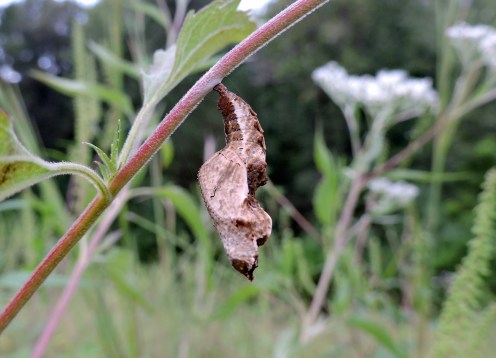
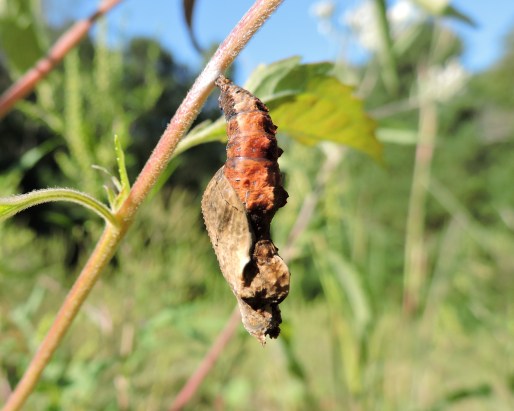
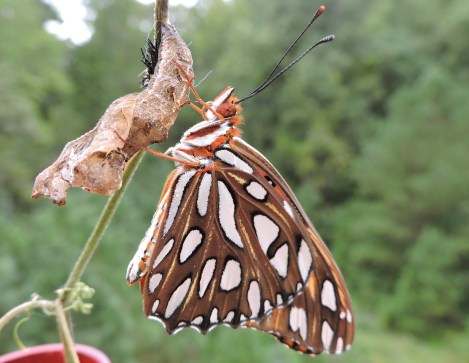
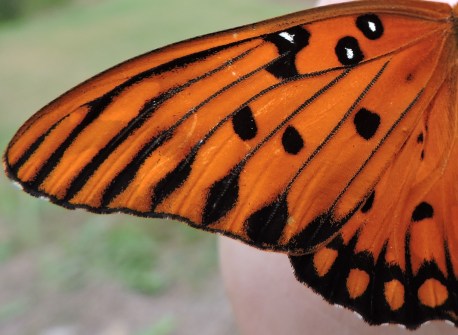
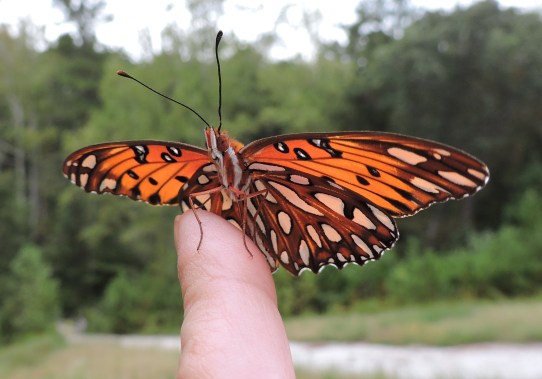
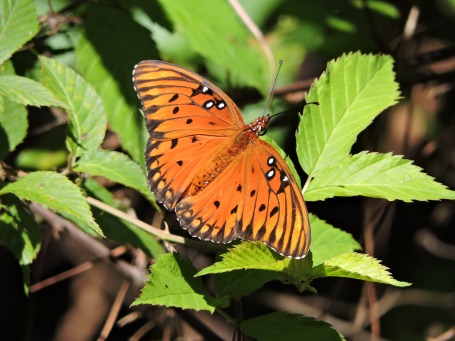
WOW, a terrific story! I know you were stunned when the bluebird swooped down and got this little beauty! It is the cycle of life, but, it had to be shocking. For those of us that photograph birds and wildlife, I understand it, but don’t know if I will ever get use to seeing the cycle unfold in front of my eyes.
Thanks for your kind words. All the time and effort leading up to that butterfly’s first flight–only to be snatched up in an instant… It’s a tough world out there!
This is an absolutely beautiful post — story, photos, and all. How sad for the butterfly, but as you indicate, at least the bluebird got a meal. We don’t have gulf fritillaries further north, as far as I know, but passionflower grows here, so maybe we will at some point.
Thank you, Nancy! So good to chat with you last week!